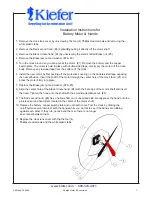
www.kiefer.com 800-323-4071
Troubleshooting Kiefer
Pace Clocks
Battery Clocks:
If the clock will not start.
• It may need a fresh battery.
• The battery may be installed incorrectly. When inserting the
battery, make sure to place it into the battery compartment
positive end first (left-hand side) and “shoe horn” the Copper
switch plate into position.
• If the motors gears are not turning properly, making noise or
are erratic check them by looking through the translucent
window on the back of the motor casing. The gears should be
spinning smoothly; if they are not, the motor is defective and
should be replaced.
• The on/off button could be worn or defective. It is replaced by
snaking the wire through the top hole and screwing the on/off button flush with the clock body.
Electric Clocks:
Instructions for installing or replacing electric motors & hands.
1. Remove clock lens cover by unscrewing the four (4) Phillips head
screws and removing the white plastic lens tabs.
2. Remove the red second hand by unscrewing the hand counter-clockwise off the shaft. The black minute hand is
removed by unscrewing the small brass nut.
3. Next from the back of the clock unscrew the motor from the face counterclockwise about 5 turns.
4. Now take the replacement motor make sure the rubber washer is installed around the motor stem and thread it into
the face clockwise about 5 turns.
5. Attach the minute hand by aligning the hand on the motor shaft with the flat edges and install the small brass nut.
Attach the red second hand by threading the hand on to the stem about 4 turns.
6. Replace the clock lens cover with the plastic lens tabs and Phillips screws and reinstall the hatch cover.
If Clock Timing is Incorrect or the Hands are Loose:
• There is a brass adjustment gear on the backside of the motor to change the minute hand setting.
• Secure the black minute hand by tightening the small brass nut.
• If hands come into contact with each other, gently bend them for clearance.
• To check for motor movement the red second hand must be attached, since it is not possible to visually detect
shaft rotation.
AKA/dag/08.04.09
Adolph Kiefer & Associates
1





















